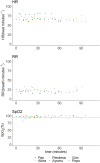Propofol infusions using a human target controlled infusion (TCI) pump in chimpanzees (Pan troglodytes)
- PMID: 33441704
- PMCID: PMC7806914
- DOI: 10.1038/s41598-020-79914-7
Propofol infusions using a human target controlled infusion (TCI) pump in chimpanzees (Pan troglodytes)
Abstract
Chimpanzees are genetically and physiologically similar to humans. Several pharmacokinetic models of propofol are available and target controlled infusion (TCI) of propofol is established in humans, but not in chimpanzees. The purpose of this study was to investigate if human pharmacokinetic models can accurately predict propofol plasma concentration (Cp) in chimpanzees and if it is feasible to perform TCI in chimpanzees. Ten chimpanzees were anaesthetized for regular veterinary examinations. Propofol was used as an induction or maintenance agent. Blood samples were collected from a catheter in a cephalic vein at 3-7 time points between 1 and 100 min following the propofol bolus and/or infusion in five chimpanzees, or TCI in six chimpanzees. Cp was measured using high-performance liquid chromatography. The Marsh, Schnider and Eleveld human pharmacokinetic models were used to predict Cp for each case and we examined the predictive performances of these models using the Varvel criteria Median PE and Median APE. Median PE and Median APE for Marsh, Schnider and Eleveld models were within or close to the acceptable range. A human TCI pump was successfully maintained propofol Cp during general anesthesia in six chimpanzees. Human propofol pharmacokinetic models and TCI pumps can be applied in chimpanzees.
Conflict of interest statement
The authors declare no competing interests.
Figures



Similar articles
-
The performance of compartmental and physiologically based recirculatory pharmacokinetic models for propofol: a comparison using bolus, continuous, and target-controlled infusion data.Anesth Analg. 2010 Aug;111(2):368-79. doi: 10.1213/ANE.0b013e3181bdcf5b. Epub 2009 Oct 27. Anesth Analg. 2010. PMID: 19861357
-
Predictive performance of the modified Marsh and Schnider models for propofol in underweight patients undergoing general anaesthesia using target-controlled infusion.Br J Anaesth. 2017 Jun 1;118(6):883-891. doi: 10.1093/bja/aex102. Br J Anaesth. 2017. PMID: 28541533 Clinical Trial.
-
Predictive performance of a new pharmacokinetic model for propofol in underweight patients during target-controlled infusion.Acta Anaesthesiol Scand. 2019 Apr;63(4):448-454. doi: 10.1111/aas.13335. Epub 2019 Jan 28. Acta Anaesthesiol Scand. 2019. PMID: 30690713
-
Intravenous anaesthesia: manual infusion schemes versus TCI systems.Anaesthesia. 1998 Apr;53 Suppl 1:42-5. doi: 10.1111/j.1365-2044.1998.53s113.x. Anaesthesia. 1998. PMID: 9640114 Review.
-
Target-Controlled Infusion of Propofol: A Systematic Review of Recent Results.J Med Syst. 2025 Apr 28;49(1):54. doi: 10.1007/s10916-025-02187-y. J Med Syst. 2025. PMID: 40289063 Free PMC article.
Cited by
-
Emergence of an erythroid cell-specific regulatory region in ABO intron 1 attributable to A- or B-antigen expression on erythrocytes in Hominoidea.Sci Rep. 2023 Mar 27;13(1):4947. doi: 10.1038/s41598-023-31961-6. Sci Rep. 2023. PMID: 36973299 Free PMC article.
-
Comparative survival analyses among captive chimpanzees (Pan troglodytes) in America and Japan.PeerJ. 2021 Aug 12;9:e11913. doi: 10.7717/peerj.11913. eCollection 2021. PeerJ. 2021. PMID: 34447626 Free PMC article.
-
The effect of remimazolam-based total intravenous anesthesia versus sevoflurane-based inhalation anesthesia on emergence delirium in children undergoing tonsillectomy and adenoidectomy: study protocol for a prospective randomized controlled trial.Front Pharmacol. 2024 Jun 25;15:1373006. doi: 10.3389/fphar.2024.1373006. eCollection 2024. Front Pharmacol. 2024. PMID: 38983921 Free PMC article.
References
-
- Goodall J. The Chimpanzees of Gombe: Patterns of Behavior. Cambridge: Harvard University Press; 1986.
-
- Goodall J. The Mind of the Chimpanzee: Ecological and Experimental Perspectives. Chicago: The University of Chicago Press; 2010.
-
- Adami C, Wenker C, Hoby S, Morath U, Bergadano A. Anaesthesia with medetomidine-ketamine-isoflurane with and without midazolam, in eight captive Chimpanzees (Pan troglodytes) premedicated with oral zuclopenthixol. Schweiz. Arch. Tierheilkunde. 2013;155:471–476. doi: 10.1024/0036-7281/a000493. - DOI - PubMed
Publication types
MeSH terms
Substances
LinkOut - more resources
Full Text Sources
Other Literature Sources
Research Materials
Miscellaneous

